The Vaishno Devi Temple is a famous Hindu shrine dedicated to Goddess Vaishno Devi.
Vaishno Devi (also known as Mata Rani, Trikuta, Ambe and Vaishnavi) stands in Katra, on the Trikuta Mountains, in the Union Territory of Jammu and Kashmir, India.
This temple is one of the 108 Shakti Peethas of Goddess Durga, worshipped here as Vaishno Devi. It is also one of the busiest pilgrimage centers in India. Every year, millions of devotees come here, and during festivals like Navaratri, the number can even reach one crore.
Vaishno Devi Temple is also among the richest temples in India. According to authors Michael Barnett and Janice Gross Stein, the shrine earns about $16 billion every year, mostly from the offerings of devotees.
Mythological Background
The legend of Vaishno Devi goes back thousands of years. Born as Vaishnavi, she was a divine incarnation formed from the combined energies of Goddess Kali, Lakshmi, and Saraswati. Her mission was to uphold righteousness and restore balance on earth. The Shakti tradition considers it to be a Shaktipeeth.
In the Mahabharata, there is a mention of a goddess living in the mountains of “Jamboo,” which is believed to be present-day Jammu. Arjun prayed to this goddess for blessings before the great war, and the Pandavas are said to be the first to worship her at the holy cave.
People say that Bhairon Nath, a Hindu Tantric, once saw young Vaishno Devi at an agricultural fair and became obsessed with her. To escape him, Vaishno Devi ran into the Trikuta Hills. When Bhairon Nath continued to chase her, she revealed her true form as Goddess Durga and cut off his head with her sword inside a cave. The spot where his head fell is now known as Bhairon Ghati, and a temple dedicated to him stands there today known as Bhairon Nath Temple.
Vaishno Devi, the embodiment of Shakti, now resides in the holy cave in the form of three pindis (rock formations), representing Maha Kali, Maha Lakshmi, and Maha Saraswati. This sacred spot is believed to fulfill the wishes of every sincere devotee.
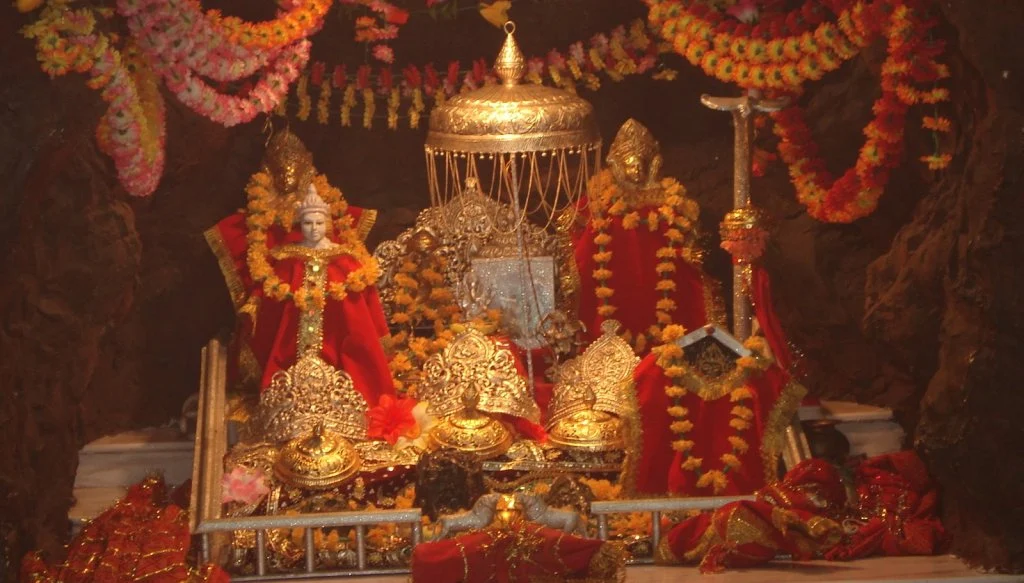
You may also explore four Adi Shaktipeethas: Vimala, Tara Tarini, Kamakhya and Kalighat.
Historical Records
Historical records about the Vaishno Devi Temple are limited, but the holy cave is believed to be very ancient. A geological study suggests that it is millions of years old. The earliest reference appears in the Mahabharata, where the Pandavas are said to have built a shrine here.
Later, Guru Gobind Singh Ji visited the cave through the old Purmandal route, which provides a documented historical link. In more recent history, about 700 years ago, Pandit Shridhar rediscovered the cave and helped in developing the temple.
The shrine gained further recognition in the 1980s, when the Shri Mata Vaishno Devi Shrine Board was formed to manage the temple and provide better amenities for the growing number of pilgrims.
Architecture: A Cave Temple with Divine Simplicity
Unlike grand temples with towering spires, Vaishno Devi Temple’s beauty lies in its natural form. The main sanctum is a cave, about 98 feet long, where water continuously flows from a rock called the Charan Ganga.
Inside the cave, the three pindis represent the goddesses without any sculpted images. Pilgrims often describe the darshan as a deeply humbling and powerful experience.
Over time, infrastructure has been added—like well-lit tunnels, railings, and safety features—but the spiritual simplicity of the shrine remains untouched.
Geographical Location
Vaishno Devi Temple is located near Katra town in the Reasi district of Jammu and Kashmir. Set at an altitude of about 5,200 feet, the temple sits inside a natural cave in the Trikuta Hills.
The 12-kilometer trek from Katra to the temple winds through scenic mountain trails, forests, and viewpoints. Pilgrims walk, ride ponies, or use palkis and electric vehicles to reach the holy cave.
No matter the method, the spiritual energy along the path touches every traveler.
How to Reach Vaishno Devi
Reaching Vaishno Devi Temple starts from Katra, which is well-connected by rail and road. The nearest major city, Jammu, lies about 63 kilometers away and has a busy railway station and airport.
By Air: Jammu Airport is the nearest, approx. 63 KM from temple.
By Train: Nearest Railway Station is Katra, nearly 13 KM away.
From Jammu, regular buses and taxis take you to Katra. Once there, the 12-kilometer yatra begins. Pilgrims can walk, take battery-operated vehicles, ride ponies, or even use a helicopter service up to Sanjichhat.
For those who cannot walk long distances, the Shrine Board provides resting shelters, medical services, and food stalls along the way.
My Journey from Kolkata
I began my spiritual journey to Vaishno Devi from Kolkata, filled with anticipation and devotion. I boarded the Sealdah–Jammu Tawi Express, which runs directly to Jammu, giving me ample time to reflect, read spiritual texts, and mentally prepare for the yatra. Watching the changing landscape through the train window—from Bengal’s green plains to the misty hills of Jammu—was truly meditative.
After reaching Jammu, I hired a shared cab to Katra, which took around 2 hours. The road curved through the foothills, and as the Trikuta Mountains came into view, I felt my heart beat faster—not from the altitude, but from the excitement of finally arriving at the starting point of this divine trek.
That night in Katra, I barely slept. The next morning, I began the 12-km climb toward the shrine. Every step echoed with chants of “Jai Mata Di.” My legs may have tired, but my soul grew stronger with every turn of the trail.
Where to Stay
Katra offers a wide range of stay options to suit every pilgrim’s budget and comfort level. From simple dharamshalas to modern hotels and government guest houses, accommodation here is designed with the devotee in mind.
During my yatra, I stayed at Durga Bhawan, a no-frills yet deeply spiritual place managed by the Shrine Board. Located near the Banganga check post, it provided basic yet clean amenities and a peaceful environment. The early morning aarti sounds echoing from nearby set the perfect tone for the day ahead. What made the stay special wasn’t luxury—it was the calm, devotional atmosphere that wrapped around me like a silent blessing. I shared tea and quiet conversations with other pilgrims, all of us united in our purpose. It truly felt like a community of faith.
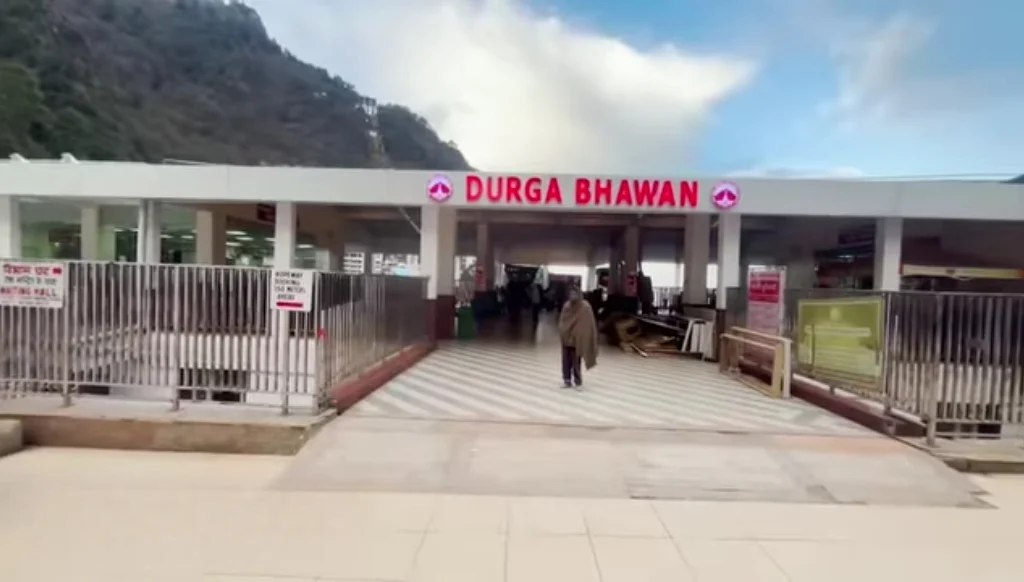
Here are some other popular options you might consider:
- Niharika Bhawan – Run by the Shrine Board, known for cleanliness and security.
- Trikuta Bhawan – Ideal for group travelers with dormitory-style rooms.
- Private Hotels in Katra – Ranging from budget lodges to 3-star comfort stays like Hotel Shree Hari Niwas and Hotel Asia Vaishno Devi.
Tip: If you’re planning to visit during Navratri or summer vacation, be sure to book your accommodation in advance. Shrine Board-run guest houses can be booked through their official website.
Best Time to Visit
Vaishno Devi Temple is open throughout the year. However, the best time to visit is between March and October. During this period, the weather is pleasant, and the path becomes easier to navigate.
Navratri, held twice a year in spring and autumn, marks the peak of spiritual energy. Thousands of pilgrims visit during these festivals, chanting and celebrating the divine feminine.
Winter months (November to February) bring heavy snowfall in the region. Though darshan is still possible, travelers must prepare for harsh cold and possible delays.
Local People and Culture
The people of Katra and surrounding regions live in close harmony with the temple. Most work in tourism-related services—running hotels, guiding pilgrims, or managing shops.
They greet visitors with respect and share stories of the Goddess with pride. Local food stalls offer simple, sattvic meals suitable for fasting devotees.
The culture here blends Dogra traditions with spiritual hospitality. Folk songs, local crafts, and traditional attire reflect the region’s rich identity.
Nearby Places of Attraction
Bhairon Nath Temple
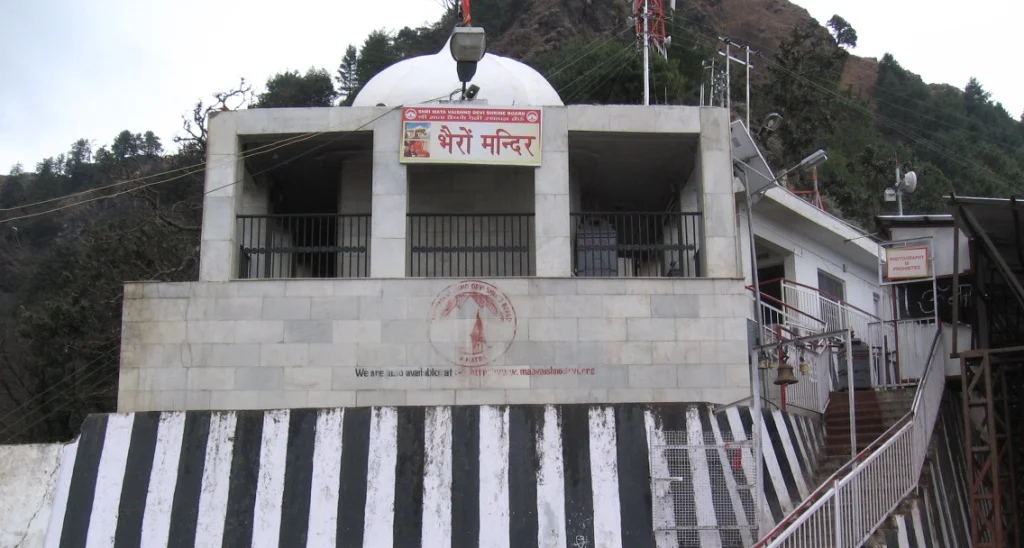
Located a few kilometers uphill from the main shrine, this temple completes the yatra and holds great significance. According to legend, the tantric saint Bhairon Nath pursued Goddess Vaishno Devi after seeing her at a fair. To evade him, she assumed the fierce form of Maa Kali and beheaded him in a cave. Bhairon’s repentance led the Goddess to forgive him and decree that no pilgrimage to Vaishno Devi is complete without visiting his temple—the site where he breathed his last.
Ardhkuwari Cave
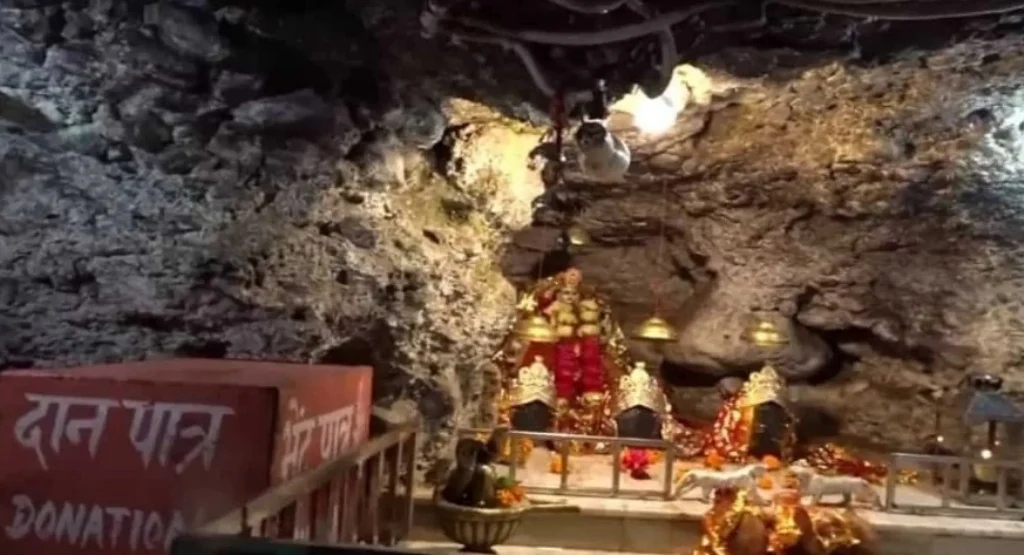
Halfway to the shrine, this cave is where Goddess Vaishnavi meditated for nine months. Legend holds that Goddess Vaishno Devi meditated in this cave for nine months, symbolically as if in a womb, while evading the demon Bhairon Nath. She later emerged, defeated him, and continued to the main shrine. The name “Ardhkuwari” is derived from Adi Kuwari, referencing the Goddess as the primordial virgin and her protective penance here. The cave is also called Garbh Joon, meaning “womb cave”.
Charan Paduka
A sacred rock said to bear the footprints of the Goddess. The name Charan Paduka translates to “divine footprints” — this spot marks where Mata Vaishno Devi paused during her journey, looking back to see if she was still being pursued by Bhairon Nath. Her footprints are believed to be etched on a rock slab here, lending the place its spiritual significance.
Jhajjar Kotli
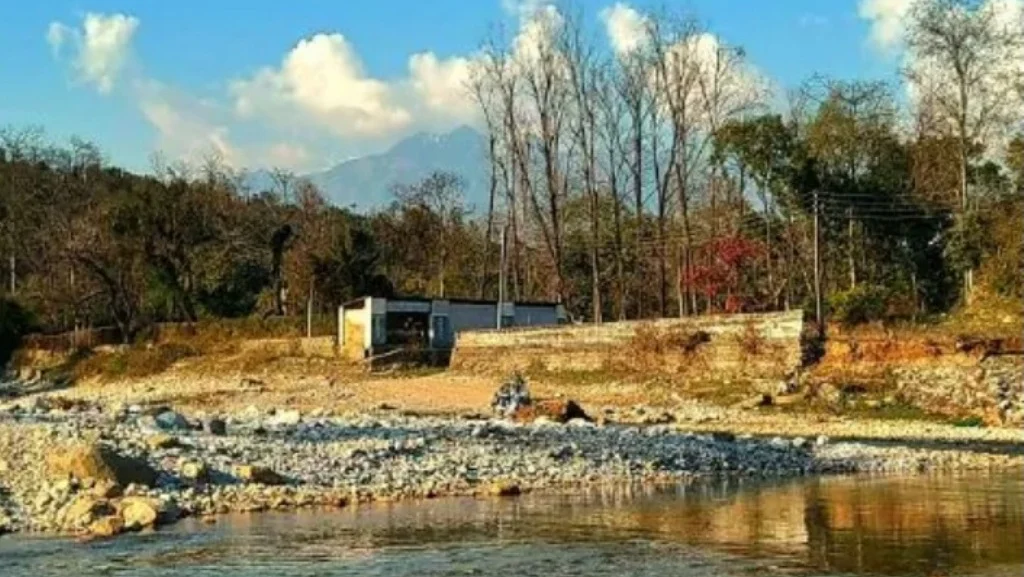
A scenic picnic spot along the river, ideal for relaxation before or after the yatra. Jhajjar Kotli (or Kotli Jhajjar) lies at about 15 km from Katra, along the Jammu–Srinagar NH‑1A, making it reachable in roughly 30 minutes by road. Nestled on the banks of the Jhajjar rivulet, its crystal-clear, cold water and lush forested surroundings make it a favorite spot for relaxation and picnics, especially during summer months.
Shivkhori Cave Temple
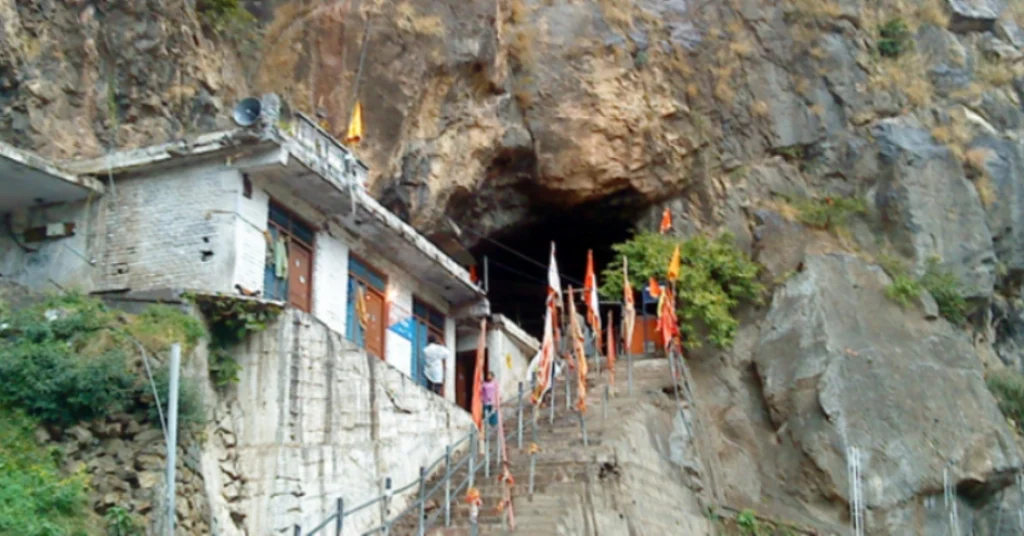
Dedicated to Lord Shiva, this mystical cave lies a few hours from Katra. Shiv Khori (also spelled Shivkhori) is a naturally formed cave shrine situated near Ransoo village in Pouni block of Reasi district, approximately 80 km from Katra, 120 km from Udhampur, and 140 km from Jammu. The cave stretches roughly 150–200 m in length, about 1 m wide and 2–3 m high. The entrance is large enough to accommodate 300 people at once.
Vaishno Devi Temple—A Journey of Faith
Vaishno Devi Temple isn’t just a religious site—it’s a personal journey. Whether you climb with chants or ride with comfort, the Goddess walks with you. Her presence fills every corner of the hills, and her blessings wait at the cave’s entrance.
With each visit, you carry back not just memories but faith, clarity, and inner peace. The journey may end, but its impact lasts forever.
Ready to Begin Your Pilgrimage?
If your heart seeks divine grace and your soul craves strength, then Vaishno Devi Temple awaits you. Plan your journey, trust the path, and let the sacred hills whisper their blessings. Have you experienced this divine yatra? Share your story and inspire others to take the first step.
May your journey to Vaishno Devi Temple be filled with strength, devotion, and endless blessings.
FAQs:
The best time to visit is between March and October. During this period, the weather is pleasant, and the path becomes easier to navigate.
To book a helicopter for Vaishno Devi, visit the official Shri Mata Vaishno Devi Shrine Board official website. Online booking opens 60 days in advance, so plan accordingly. One-way ticket from Katra to Sanjichhat typically costs around Rs.2,100 per person. Round-trip tickets (Katra to Sanjichhat and back) are also available, usually priced around Rs.4,200 per person.
Shrine board accommodation can be booked at the Enquiry and Reservation Counter in Niharika Complex near the Katra Bus Stand.
Total distance is 13 km from Katra to Bhawan (main temple).
No, Mobile phones and cameras are not allowed inside the Ardhkuwari temple and main Bhawan.
Katra is the starting point for the Vaishno Devi yatra.



